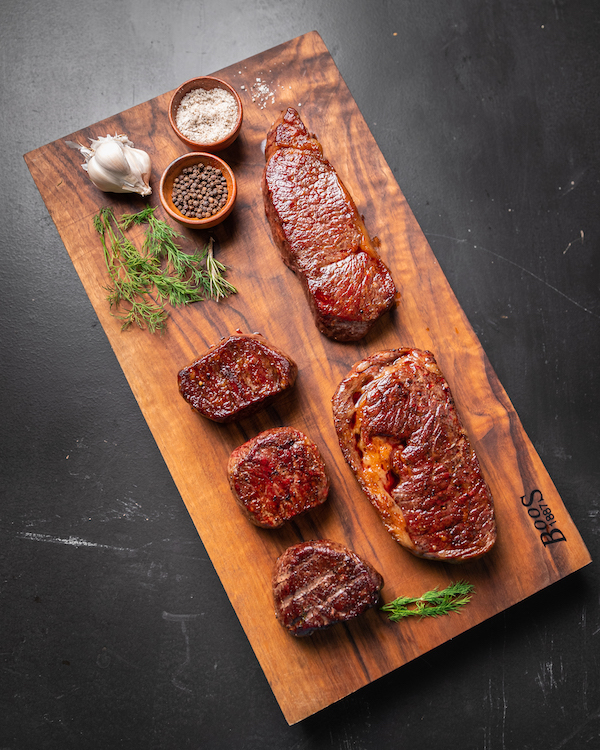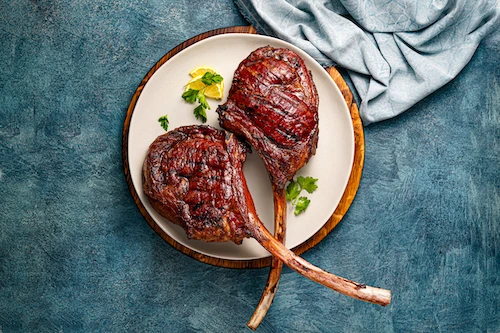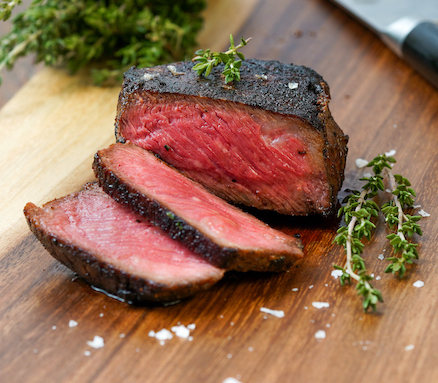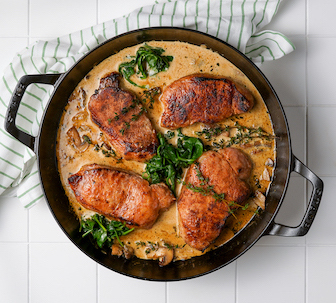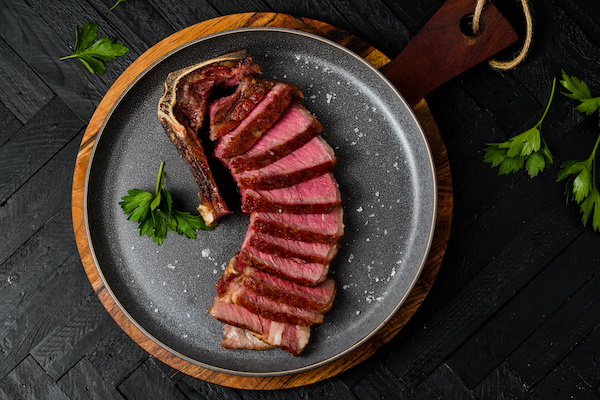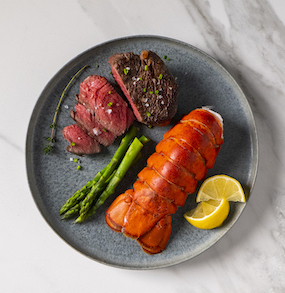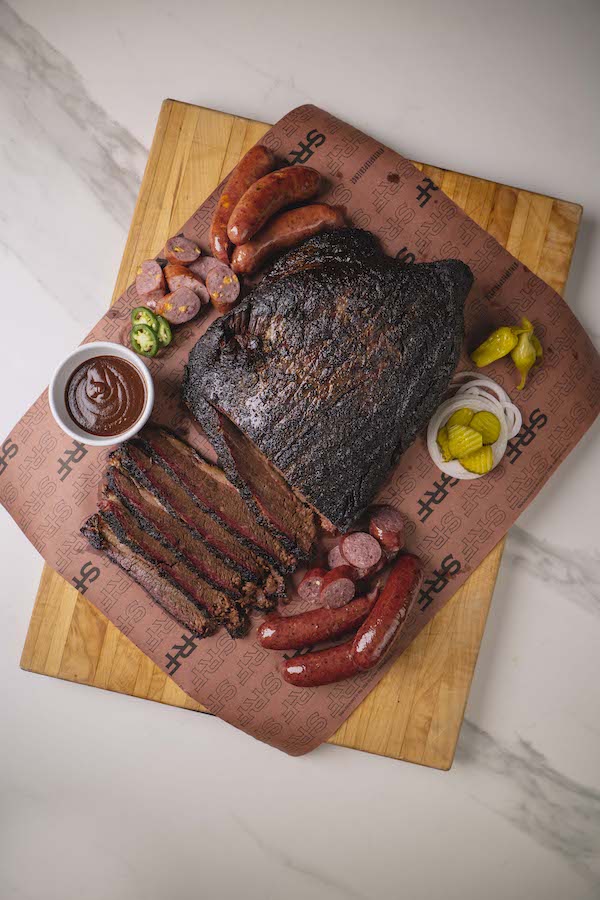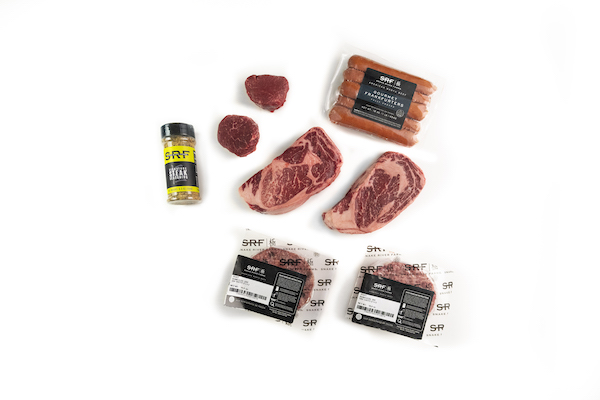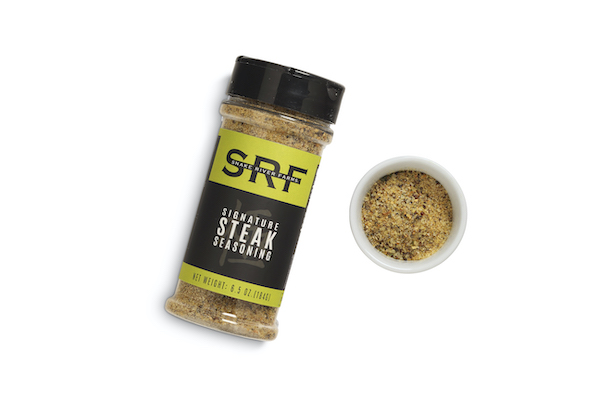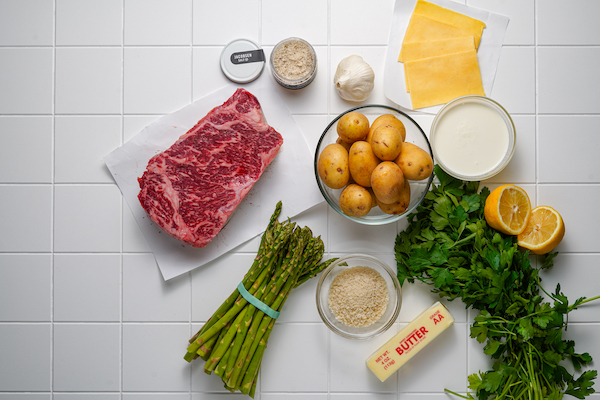Ribeye Filets with Bone Marrow Bordelaise
Ingredients
Steaks
-
4 Snake River Farms American Wagyu Ribeye Filets Buy Now
-
1 tablespoon beef tallow (or other high smoke point oil)
-
2 tablespoons unsalted butter
-
2 sprigs of rosemary
-
4 sprigs of thyme
-
Salt
Beef Stock
-
1 pound marrow bones, cut crosswise if possible
-
1 ½ pounds mixed beef knuckle bones and oxtail
-
½ onion, cut into large chunks (½ an inch)
-
1 medium-sized carrot, cut into large chunks (½ an inch)
-
1 stalk of celery, cut into large chunks (½ an inch)
-
½ tablespoon of tomato paste
-
1 cup of dry, full-bodied, red wine
-
1 teaspoon apple cider vinegar
-
½ tablespoon of black peppercorns
-
½ bunch of parsley (just the stems, save the leaves for another use)
-
3 sprigs of thyme
-
2 bay leaves
-
3 cloves of garlic, crushed
Bordelaise
-
Beef Stock
24 hours before you want to eat, dry brine your steaks. Season each steak with about 1 teaspoon of kosher salt, making sure to cover the whole surface. Airflow is important in dry brining, so place your steaks on a rack over a baking sheet or plate to catch any drippings. Place them in the refrigerator, uncovered, for 24-36 hours.
Heat the oven to 415° F.
Heat a tablespoon of beef tallow (or other high smoke point oil) in a large cast iron skillet over medium-high heat. Once it just barely starts to smoke, add your steaks. Sear on one side for 2 minutes. Flip the steaks and add 2 tablespoons of butter, a sprig of rosemary, and a couple of sprigs of thyme to the butter. Continue to sear for 2 minutes, tilting the pan to baste the steaks with the herb butter.
Put the cast iron into the oven and cook to your desired temperature, about 8-10 minutes for medium-rare steaks.
When they’re ready, take the steaks out of the oven and let them rest on a plate for 5-7 minutes while you finish the sauce.
Taking the same cast iron you cooked your steaks in, pour out the excess fat and get rid of the sprigs of herbs. Do not scrape the cast iron – you want the browned bits from cooking the steaks.
Put the cast iron back on medium heat and deglaze the pan with about ⅓ of a cup of red wine and let it reduce until thick and syrupy.
Add the reduced stock to the cast iron with a fresh sprig of rosemary and turn the heat to low. Break up the reserved, cold marrow, and put it in the sauce, stirring constantly to emulsify as the marrow melts into the sauce. Taste the sauce and add salt if necessary. If it’s too thick, slowly drizzle in water while stirring. If the steaks have released any juices while resting, add that to your sauce as well.
SERVING- Drizzle your steaks with a couple of tablespoons of sauce – a little goes a long way. Serve immediately, before the sauce cools and thickens.
At the same time you prepare the steaks, it’s recommended you start your stock so you have time to cook and let it chill to remove the fat. But you can start it 8 to 9 hours before you want to cook dinner and just make the sauce all in one day.
Preheat the oven to 450° F.
Place your marrow bones in a large Dutch oven or pot (at least 5 quarts). Ideally, the bones will be cut crosswise, so they fit into the pot easier. If they are cut lengthwise, try to use a pot where they lay flat. Put into the oven and roast until the marrow is soft and the bones are browned, about 30-45 minutes.
On a baking sheet, arrange the knuckle bones and/or oxtail so they are not touching. Put them into the oven and roast until browned, about 25-35 minutes.
Once the knuckle and oxtail bones are done, take them off the baking sheet and set aside in a large bowl. Using about ¼ cup of red wine, pour it onto the still-hot baking sheet to deglaze. Use a wooden spoon or spatula to scrape the browned bits off the baking sheet. Pour the red wine and drippings into the large bowl with the bones.
Once the marrow bones are ready, pull the Dutch oven out of the oven. Remove the bones from the Dutch oven and set them aside to cool slightly before handling. Once they are cool enough to touch, use a small spoon or knife to remove the marrow. Lightly break up the marrow with the spoon or knife and put it in a small container to save in the refrigerator until ready to finish the sauce.
Put the Dutch oven (with the 1-2 tablespoons of rendered fat from the marrow bones) on medium-high heat on your stovetop. Add your chopped onions, carrots, and celery, and cook until browned, about 5-7 minutes.
Turn the temperature down to medium and add your tomato paste and stir to coat the vegetables. Using another ¼ cup of wine, deglaze the pan and scrape up the browned bits at the bottom. If the wine evaporates before you can finish scraping the pan, add a little bit more.
Put all the bones into the Dutch oven with enough water to cover the bones (between 1-2 quarts). Add in the apple cider vinegar, parsley stems, thyme, bay leaves, garlic, and peppercorns. Turn the temperature up to medium-high to bring the stock to a simmer. Once the stock is bubbling, reduce and let simmer for 5-7 hours, but no more than 8. Skim the top of the stock with a large spoon or ladle every so often to remove scum and fat.
Once your stock is ready, use tongs or a large slotted spoon to remove the bones and any large pieces from the stock. This will make it easier for you to pour it through a strainer without making a mess. Once you have removed all the big debris from the stock, pour it through a strainer into a container and reserve it in the fridge until you are ready to make the sauce.
About 2 hours before you want to cook your steaks, remove the reserved stock from the fridge. The fat should have solidified on the top so you can easily remove it.
Pour the stock into a saucepan or pot and turn to medium heat. Simmer it gently until it reaches the nappe stage. To test, gently stir the sauce and when you pull the spoon out of the sauce, run your finger through the sauce on the back of the spoon. If the sauce fills in the space, it needs to reduce more. If it doesn’t, then it’s ready. If you take it too far, you can add water to thin it out. It should be reduced by about 75% by the end.
Once reduced, set the sauce aside, keeping warm, while you cook the steaks.

